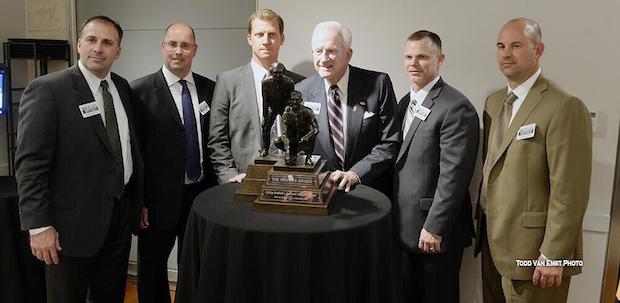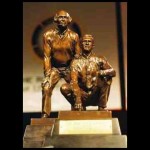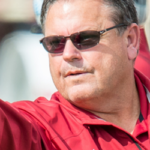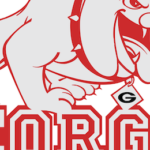And the winner of the 2013 Broyles Award is Michigan State’s Pat Narduzzi.
Here is Pat Narduzzi’s bio:
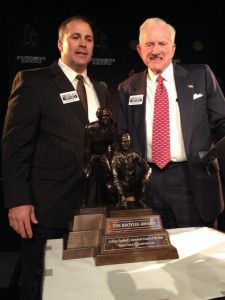 Now in his seventh season as Michigan State’s defensive coordinator, Pat Narduzzi has developed the Spartans into one of the top defensive teams in the nation. Narduzzi was promoted to assistant head coach on March 4, 2013.
Now in his seventh season as Michigan State’s defensive coordinator, Pat Narduzzi has developed the Spartans into one of the top defensive teams in the nation. Narduzzi was promoted to assistant head coach on March 4, 2013.
The Spartans are one of just five NCAA Football Bowl Subdivision schools, along with Alabama, Florida State, Florida and LSU, to rank among the top 10 nationally in total defense the past two seasons. In addition, MSU and Alabama are the only two programs in the country to rank in the NCAA FBS Top 15 the past two seasons in total defense, rushing defense, passing defense and scoring defense.
For the second straight year, Michigan State featured the best defense in the Big Ten in 2012. The Spartans ranked among the NCAA FBS Top 10 in eight categories: touchdowns allowed (second with 16), pass efficiency defense (third at 98.8), total defense (fourth at 274.4 ypg.), pass break-ups (tied for eighth at 4.8 pg.), rushing defense (eighth at 98.6 ypg.), third-down defense (eighth at .305), pass defense (ninth at 175.8 ypg.) and scoring defense (ninth at 16.3 ppg.). In addition, MSU also led the Big Ten in six defensive categories (touchdowns allowed, total defense, scoring defense, pass efficiency defense, rushing defense and third-down defense).
Seven starters, including first-team choices Johnny Adams (cornerback), Max Bullough (linebacker) and Darqueze Dennard (cornerback), earned All-Big Ten accolades. During Narduzzi’s tenure at MSU, his players have earned All-Big Ten honors 48 times, including eight different first-team selections.
The foundation of Michigan State’s defense is stopping the run, and Narduzzi’s unit once again proved it could stop the rush in 2012. The Spartans led the Big Ten and ranked eighth in the NCAA FBS in rushing defense, allowing just 98.6 yards per game, which also marked one of the top defensive efforts in Spartan history (10th-fewest allowed). Five teams (Boise State, Eastern Michigan, Wisconsin, Northwestern, Minnesota) posted their season lows in rushing against the Spartans, and MSU held eight opponents to under-100 yards rushing. MSU has finished in the top 25 nationally in rushing defense three of the past four seasons (24th in 2009; ninth in 2011; eighth in 2012). Since the beginning of 2011, Michigan State has held 15 opponents under 100 rushing yards (seven in 2011; eight in 2012), which ranks fifth most in the NCAA FBS (Alabama: 21; Florida State: 19; Stanford: 17; LSU: 16).
Michigan State led the Big Ten and ranked No. 4 in the NCAA FBS in total defense, permitting just 274.4 yards per game, which was the lowest season average (total defense) since 1987 (241.0 ypg.). The Spartans also led the conference and ranked No. 9 in the NCAA FBS in scoring defense, allowing just 16.3 points per game. Michigan State held four opponents (Boise State, Central Michigan, Michigan, Minnesota) without an offensive touchdown and shut out three opponents in the second half (Boise State, Eastern Michigan, Indiana). In fact, Michigan State’s defense allowed just 74 points in the second half/overtime all season (five touchdowns, 13 field goals). The last time MSU permitted a lower scoring average came in 1989 (13.6 ppg.).
The Spartans surrendered just 16 offensive touchdowns (six rushing, 10 passing) – the second-fewest allowed in the NCAA FBS in 2012. Only Notre Dame (15) permitted fewer TDs. MSU also ranked tied for third in the nation in rushing touchdowns allowed (6). In addition, the Spartans forced their opponents to go three-and-out on 68 of 167 possessions (41 percent; 5.23 per game – fourth in the NCAA FBS).
In 2011, the Spartans led the Big Ten in rushing defense (100.5 yards per game), total defense (277.4 ypg.), interceptions (18) and third-down defense (.337). The Spartans also ranked among the conference leaders in passing efficiency defense (second with a 113.3 rating), sacks (second with 45), tackles for loss (second with 105), turnover margin (third at +0.50 per game), red-zone defense (third at .763), passing defense (third at 176.9 ypg.), scoring defense (third at 18.4 points per game) and takeaways (fourth with 25).
MSU ranked among the NCAA FBS Top 20 in seven statistical categories: sixth in total defense, seventh in sacks, ninth in rushing defense, 10th in scoring defense, 11th in pass defense, 14th in tackles for loss and 18th in pass efficiency defense. The Spartans held five teams to their season lows in total offense (Florida Atlantic, Central Michigan, Ohio State, Michigan, Indiana) during the regular season and on five occasions, MSU limited their opponent to seven points or less. Four teams (FAU, CMU, Ohio State, Georgia) posted their season lows in rushing against the Spartans, and MSU held seven opponents to under-100 yards rushing.
Every single MSU starter on defense – which featured only two seniors – received All-Big Ten recognition, either on the first team, second team, or honorable mention, establishing a school record. Three players earned first-team All-Big Ten honors, including junior defensive tackle Jerel Worthy, who also garnered consensus first-team All-America accolades. Worthy was the third Spartan to be named an All-American under Narduzzi, joining Jonal Saint-Dic (2007) and Greg Jones (2009-10). Narduzzi has also coached three Freshman All-Americans at MSU (Jones in 2007; Worthy in 2009; Marcus Rush in 2011).
Senior safety Trenton Robinson (media), who ranked second in the Big Ten with four interceptions, and junior cornerback Johnny Adams (coaches), who led MSU with nine passes defended, were also named to the first team.
In addition to the three first-team selections, eight more Spartan defenders received All-Big Ten recognition on either the second team or honorable mention. Sophomore defensive lineman William Gholston and sophomore safety Isaiah Lewis were named to the second team by the coaches and the media, sophomore linebacker Max Bullough picked up second-team honors from the coaches, and sophomore linebacker Denicos Allen garnered second-team accolades from the media. Sophomore cornerback Darqueze Dennard, junior linebacker Chris Norman, senior defensive tackle Kevin Pickelman and red-shirt freshman defensive lineman Marcus Rush all earned honorable mention.
Worthy was selected in the second round of the 2012 National Football League Draft by the Green Bay Packers, while Robinson was chosen in the sixth round by the San Francisco 49ers. A total of seven Spartan defensive players have been drafted in Narduzzi’s tenure.
For the second year in a row, Narduzzi was named the National Coordinator of the Week by Rivals.com following Michigan State’s victory over Michigan. The Spartans held Michigan to regular-season lows in total offense (250 yards), rushing (82 yards) and points (14) in 2011.
During Michigan State’s 2010 Big Ten Championship season, the Spartans ranked among the NCAA FBS leaders in rushing defense (No. 21 allowing 121.9 ypg.), scoring defense (No. 26 allowing 20.1 ppg.), total defense (No. 31 allowing 337.8 ypg.) and pass efficiency defense (No. 33 with a 117.0 rating) in the regular season. In addition, MSU allowed only one 100-yard rusher all season (Game 11 against Purdue, Keith Carlos: six rushes for 103 yards and one touchdown).
The biggest difference in MSU’s turnaround was takeaways – after forcing just 14 all of 2009, MSU totaled 24 in 2010. The Spartans recorded 17 interceptions, its highest total since 2004, which ranked third in the Big Ten and tied for 23rd in the nation. Michigan State’s +0.38 turnover margin was ranked 31st in the FBS.
MSU ranked fifth in the Big Ten and 37th in the nation in rushing defense, allowing just 134.0 yards per game. The Spartans held both Wisconsin and Michigan to season-low rushing totals in victories against the Badgers and Wolverines.
Senior linebacker Greg Jones became just the seventh player in program history to earn first-team honors three times. Jones, who led the team with 106 tackles, also earned consensus first-team All-America accolades for the second straight year, making him just the third Spartan to accomplish that feat (George Webster and Bubba Smith, 1965-66).
In addition to Jones, six more Spartan defenders received All-Big Ten recognition on either the second team or honorable mention in 2010. Senior linebacker Eric Gordon was a second-team pick by both the coaches and media, while the entire secondary (cornerbacks Johnny Adams and Chris L. Rucker; safeties Marcus Hyde and Trenton Robinson) was honored.
Narduzzi was named the National Coordinator of the Week by Rivals.com after the Spartans held Michigan to a season-low 162 rushing yards as Michigan State handed the Wolverines their first loss of the season, 34-17, on Oct. 9. The Spartans also limited Michigan to 17 points and 377 total yards, the second-lowest output for the Michigan offense in those categories during the regular season. Michigan entered the game averaging 41.4 points, 565.0 yards of total offense and 324.4 rushing yards per game. MSU also held Denard Robinson, the nation’s No. 1 rusher at the time, to his fourth-fewest rushing yards all season (86).
In 2009, Jones became the first Spartan to be named Big Ten Defensive Player of the Year. He earned consensus first-team All-America honors and also garnered first-team All-Big Ten accolades for the second straight season after leading the conference and ranking third nationally with 154 tackles. Jones was rated the No. 1 linebacker in the nation by CollegeFootballNews.com and earned the Linebacker Trophy (Linebacker of the Year) by the College Football Performance Awards.
In addition to Jones, Worthy was named a Freshman All-American after ranking second on the team in tackles for loss (9 for 34 yards) and sacks (4.5 for 23 yards). Overall, four Spartans on defense were recognized with All-Big Ten honors in 2009, including honorable mention selections Trevor Anderson, Chris L. Rucker and Jeremy Ware. Ware was selected in the seventh round of the 2010 NFL Draft by Oakland.
Michigan State’s strength in 2009 was stopping the run, as the Spartans ranked fourth in the Big Ten and 24th nationally by allowing just 113.2 rushing yards a game. MSU limited their opponents to fewer than 100 rushing yards in six games during the season. The Spartans also put pressure on the quarterback, ranking third in the conference and 17th (tied) in the country with 35 sacks.
The Spartan defense featured several playmakers in 2008, as Narduzzi tutored six players on the defensive side of the ball to All-Big Ten honors. MSU placed two players – Jones and safety Otis Wiley – on the All-Big Ten first team, marking the first time since 2000 that the Spartans have had two defensive first-team selections in the same season. Jones, who led the Big Ten during conference play in tackles, was the first Spartan linebacker in seven years to garner first-team All-Big Ten accolades. Wiley anchored the Spartan secondary and ranked among the league leaders in interceptions (4) and passes defended (11). MSU’s defensive line, which featured three honorable mention selections, included seniors Justin Kershaw and Brandon Long, who both recorded career highs in sacks and tackles for loss.
Michigan State’s defense saw marked improvement in 2007 under Narduzzi’s direction. The Spartans recorded 40 sacks, 24 more than it produced the entire 2006 season. In fact, the 40 sacks were the third-highest total in MSU single-season history and exceeded the Spartans’ combined sack totals for the previous two seasons (32). The Spartans ranked fourth in the Big Ten (tied) and No. 14 in the NCAA, averaging 3.08 sacks a game. By comparison, the Spartans finished 10th in the conference and No. 103 nationally in sacks in 2006, averaging just 1.33 per game. MSU also finished third in the conference and 11th in the nation in tackles for loss with 7.69 per game. In addition, MSU ranked fourth in the Big Ten and 30th nationally in rushing defense (125.8 yards per game).
Three Spartans garnered All-Big Ten accolades on the defensive side of the ball, including first-team selection (defensive end) Jonal Saint-Dic, who set a Big Ten single-season record and led the nation with eight forced fumbles. Defensive end Ervin Baldwin led the team with 18.5 tackles for losses, the second-best total in school history, and was taken in the seventh round of the NFL Draft by Chicago. Jones proved to be one of the top newcomers in the country, earning Freshman All-America honors after leading the team with 78 tackles.
Narduzzi, who served as Mark Dantonio’s defensive coordinator all three years at Cincinnati, developed a solid defensive unit during his tenure with the Bearcats.
In 2006, Cincinnati ranked among the national leaders during the regular season in tackles for loss (No. 21 at 6.8 per game), pass efficiency defense (No. 23 at 109.3 rating), rushing defense (No. 27 at 107.5 ypg.), total defense (No. 31 at 304.3 ypg.), scoring defense (No. 34 at 19.3 ppg.) and sacks (No. 34 at 2.3 pg.). UC held seven of its 12 opponents to less than 100 yards rushing. In UC’s 30-11 win over then-No. 7 Rutgers on Nov. 18, the Bearcats held the nation’s No. 20 rushing offense to a season-low 50 yards on the ground, and held the nation’s No. 3 rusher, Ray Rice, to a season-low 54 yards. Middle linebacker Kevin McCullough led the team in tackles and ranked fifth in the BIG EAST with 13.5 tackles for loss. Defensive end Trevor Anderson ranked sixth in the BIG EAST in both tackles for loss (13.0) and sacks (6.0).
In his first season as defensive coordinator at UC in 2004, Narduzzi constructed the defense which led the Bearcats to a runner-up finish in Conference USA and a victory in the Fort Worth Bowl. The secondary ranked 26th in the nation and first in C-USA in pass defense. The Bearcats also ranked second in C-USA and 38th nationally in total defense, and third in the conference in scoring defense and pass efficiency defense. Three Bearcat defenders from that team: Trent Cole, Tyjuan Hagler and Daven Holly, were taken in the NFL Draft, while six others earned all-league recognition. UC’s 2005 defense had as many as eight first-year freshman starters, and Narduzzi helped groom two of them, Mike Mickens and Corey Smith, to second-team All-BIG EAST and Freshman All-America honors.
Prior to his arrival in Cincinnati, Narduzzi was the architect of the Miami-Ohio defense in 2003 which helped the RedHawks to a No. 10 finish in the national polls, a Mid-American Conference championship and a win over Louisville in the GMAC Bowl. Miami-Ohio ranked first in the MAC in rushing defense (19th nationally), scoring defense (22nd nationally) and pass efficiency defense (34th nationally). The RedHawks also ranked second in the MAC and 35th nationally in total defense.
Narduzzi previously helped Northern Illinois to a pair of MAC divisional titles during his three seasons in DeKalb (2000-02) as linebackers coach. In 2002, the Huskies had the league’s stingiest defense against the run and were ranked 38th nationally. Narduzzi coached with offensive coordinator Dan Roushar for three seasons while he was at NIU.
Narduzzi, who has compiled 23 seasons of coaching experience, began his career at Miami-Ohio in 1990, serving two seasons as a graduate assistant and one as a receivers coach in 1992.
In 1993, he started a seven-year tenure at Rhode Island, and served as defensive coordinator from 1998-99. Narduzzi and Roushar also crossed paths at Rhode Island for one season (1993), when Narduzzi was coaching linebackers and Roushar was coaching the offensive line.
A Youngstown, Ohio, native, Narduzzi earned all-state football honors at Ursuline High School. He played for his father Bill Narduzzi at Youngstown State as a freshman in 1985 and led the Ohio Valley Conference in tackles. Narduzzi then transferred to Rhode Island and became a three-year starter at linebacker for the Rams from 1987-89.
Narduzzi completed his bachelor’s degree in physical education at Rhode Island in 1990 and later earned a master’s degree in sports psychology at Miami-Ohio in 1992. Narduzzi and his wife Donna have four children: Arianna, Christina, Patrick and Isabella.
THE NARDUZZI FILE
YEARS AT MICHIGAN STATE: Seventh. Joined staff on Dec. 6, 2006, from Cincinnati.
PREVIOUS COACHING EXPERIENCE: College – Graduate assistant coach (1990-91) and receivers coach (1992) at Miami-Ohio; linebackers (1993-97) and defensive coordinator (1998-99) at Rhode Island; linebackers coach at Northern Illinois (2000-02); defensive coordinator at Miami-Ohio (2003); defensive coordinator at Cincinnati (2004-06).
EDUCATION: Bachelor’s degree in physical education from Rhode Island in 1990; master’s degree in sports psychology from Miami-Ohio in 1992.
PLAYING EXPERIENCE: College – Three-year starter at linebacker at Rhode Island (1987-89); one year at linebacker at Youngstown State (1985).
POSTSEASON EXPERIENCE: Coach – 2003 GMAC Bowl, 2004 Fort Worth Bowl, 2007 Champs Sports Bowl, 2009 Capital One Bowl, 2010 Valero Alamo Bowl, 2011 Capital One Bowl, 2012 Outback Bowl, 2012 Buffalo Wild Wings Bowl.
The Broyles Award selection committee chose the following five finalists for the 2013 Broyles Award:
- Rhett Lashlee, Offensive Coordinator/Quarterbacks, Auburn
- Philip Montgomery, Offensive Coordinator, Baylor
- Kurt Roper, Offensive Coordinator/Quarterbacks, Duke
- Jeremy Pruitt, Defensive Coordinator, Florida State
- Pat Narduzzi, Defensive Coordinator, Michigan State
All Nominees Announced For 2013 Broyles Award Are Listed Below
The Rotary Club of Little Rock is pleased to announce the nominees for the 2013 Broyles Award:
- Alabama – Doug Nussmeier, Offensive Coordinator
- Arizona – Jeff Casteel, Defensive Coordinator
- Arizona State – Mike Norvell, Offensive Coordinator
- Arkansas State – Kent Riddle, Assistant Head Coach, TE’s/Special Teams
- Auburn – Rhett Lashlee, Offensive Coordinator
- Ball State – Rich Skrosky, Offensive Coordinator
- Baylor – Philip Montgomery, Offensive Coordinator
- Boston College – Don Brown, Defensive Coordinator
- Brigham Young – Nick Howell, Defensive Coordinator
- Central Florida – Brent Key, Assistant Head Coach/Offensive Line
- Colorado State – Dave Baldwin, Offensive Coordinator
- Clemson – Chad Morris, Offensive Coordinator
- Duke – Kurt Roper, Offensive Coordinator
- Florida State – Jeremy Pruitt, Defensive Coordinator
- Fresno State – Dave Schramm, Offensive Coordinator
- Georgia Tech – Ted Roof, Defensive Coordinator
- Houston – David Gibbs, Defensive Coordinator
- Indiana – Seth Littrell, Offensive Coordinator
- Iowa – Phil Parker, Defensive Coordinator
- Louisville – Vance Bedford, Defensive Coordinator
- LSU – Cam Cameron, Offensive Coordinator
- Michigan State – Pat Narduzzi, Defensive Coordinator
- Minnesota – Tracy Claeys, Defensive Coordinator
- Missouri – Josh Henson, Offensive Coordinator
- Nebraska – Tim Beck, Offensive Coordinator
- Ohio State – Tom Herman, Offensive Coordinator
- Oklahoma State – Glenn Spencer, Defensive Coordinator
- Ole Miss – Dan Werner, Co-Offensive Coordinator
- Rice – Chris Thurmond, Defensive Coordinator
- San Jose State – Jimmie Dougherty, Offensive Coordinator
- South Carolina – Lorenzo Ward, Defensive Coordinator
- South Florida – Stu Holt, Special Teams Coordinator
- Stanford – Derek Mason, Defensive Coordinator
- Texas State – Mike Schultz, Offensive Coordinator
- UCLA – Jeff Ulbrich, Assistant Head Coach/LB’s/Special Teams
- Utah – Ilaisa Tuiaki, Defensive Line
- Utah State – Todd Orlando, Defensive Coordinator/Safeties
- Virginia Tech – Torrian Gray, Defensive Secondary Coach/Pass Game Coordinator
- Western Michigan – Charles Huff, RB Coach
- Wisconsin – Dave Aranda, Defensive Coordinator/LB’s
The 2013 Broyles Award winner will be announced on Tuesday, December 10 at 11:30 a.m. at the Marriott Hotel in Little Rock, AR. The Broyles Award is presented by The Rotary Club of Little Rock. The winner of the 2012 Broyles Award was Bob Diaco, Notre Dame.
The Broyles Award honors the top assistant college football coach in America and was established in 1996 to honor legendary Arkansas Head Coach Frank Broyles. Coach Broyles had a track record of producing some of the most successful assistant coaches in college football history.
The Broyles Award is a member of the National College Football Awards Association (NCFAA) which encompasses the most prestigious awards in college football. The 21 awards boast 678 years of tradition-selection excellence. Visit www.NCFAA.org to learn more about our story.
***
In 1996, the Broyles Award was established to recognize some of the most dedicated, hardest working people in America…the college football assistant coach. And, over the years, the award has done just that. Each year the five Broyles Award finalists are chosen from almost 1,500 assistant coaches representing 117 Division One college football programs. Each head coach can nominate one assistant coach from his staff. All nominations are reviewed by, and the five finalists chosen by, an enthusiastic selection committee comprised of 9 of college football’s finest former head coaches.
1999 marked the beginning of a new award presented at the cermonies. The Lifetime Achievement Award has been given to former Texas A&M assistant coach Ray Dorr, San Diego State assistant coach Claude Gilbert, and LSU’s Charlie McClendon for their many contributions to the game of college football.
In the prestigious history of college football, there are few coaches whose efforts have forever impacted the game. Bear Bryant, Knute Rockne, Frank Leahy and Eddie Robinson have set the standard for victories and championships on the gridiron. However, when it comes to selecting, developing and producing great assistant coaches, the legacy of Frank Broyles stands alone.
- 15% of All Super Bowls
- 5 College National Championships
- More Than 40 Conference Titles
- Over 2,000 Victories
Interesting Stats
89 finalists honored, representing 48 universities
(73 actual coaches honored including multi-year finalists)
13 finalist classes include 5 assistants
4 finalist classes include 6 assistants-2000, 2001, 2004, 2005 (ties in voting)
From Broyles Award to Head Coach
30 of 73 Broyles Award finalists and winners through 2012 have gone on to become
head coaches, that’s 40% of all Broyles’ finalists and winners.
20 are still active head coaches
5 of those coaches have won National Head Coach of the Year Honors
4 won conference coach of the year honors in 2012: Will Muschamp-Florida, Charlie Strong-Louisvlle, Gary Anderson-Utah State, David Cutcliffe-Duke
3 finalists were selected as head coaches following the 2012 season: Kliff Kingsbury-Texas
Tech, Bryan Harsin-Arkansas State, Paul Petrino-Idaho
Broyles Award Winners & Finalists currently serving as Head Coaches
1 Gary Patterson TCU (National Head Coach of the Year 2011)
2 Chris Peterson Boise State (National Head Coach of the Year 2006 & 2009)
3 Will Muschamp Florida (SEC Co-Head Coach of the Year 2012)
4 Jimbo Fisher Florida State
5 Charlie Strong Louisville (Big East Head Coach of the Year 2012)
6 Mark Dantonio Michigan State (Head Coach of the Year 2010)
7 Gus Malzahn Auburn
8 Gary Anderson Utah State (WAC Head Coach of the Year 2012)
9 Dana Holgerson West Virginia
10 David Cutcliffe Duke (ACC Head Coach of the Year 2012)
11 Paul Chryst Pittsburgh
12 Dave Christenson Wyoming
13 Kevin Wilson Indiana
14 Jeff Quinn Buffalo
15 Garrick McGee UAB
16 Norm Chow Hawaii
17 Paul Petrino Idaho
18 Jim Svoboda Central Missouri
19 Bryan Harsin Arkansas State
20 Kliff Kingsbury Texas Tech
Other Winners & Finalists who became Head Coaches(Currently Non Active)
21 Gene Chizik Auburn, Iowa St (National Head Coach of the Year 2010)
22 Ralph Friedgen Maryland (ACC Coach of the Year 2010)
23 Mark Mangino Kansas (National Head Coach of the Year 2007)
24 Randy Shannon Miami
25 Chuck Long San Diego State
26 Keith Burns Tulsa
27 Norries Wilson Columbia
28 Stan Parrish Ball State
29 Shane Montgomery Miami of Ohio
30 Carl Torbush North Carolina
- Joe Gibbs – Washington Redskins
- Hayden Fry – Iowa, SMU, North Texas
- Johnny Majors – Pittsburgh, Tennessee
- Barry Switzer – Oklahoma, Dallas Cowboys
- Jimmy Johnson – Miami, Dallas Cowboys, Miami Dolphins, Oklahoma St,
- Jackie Sherrill – Pittsburgh, Texas A&M, Mississippi St, Washington St
- Raymond Berry – New England Patriots
- Doug DIckey – Florida, Tennessee
- Pepper Rogers – UCLA, Georgia Tech, Kansas
- Hootie Ingram – Clemson
- Bo Rein – LSU, North Carolina State
- Jim Mackenzie – Oklahoma
- Jerry Claiborne – Maryland, Kentucky
- Jim Carlen – South Carolina, Texas Tech
- Pat Jones – Oklahoma State
- Bill Lewis – Georgia Tech, East Carolina, Wyoming
- Richard Williamson – Tampa Bay, Memphis State
- Richard Bell – South Carolina
- Bill Pace – Vanderbilt
- Charley Coffey – Virginia Tech
- Harold Horton – Central Arkansas
- Ken Turner – Henderson State
- Ken Stephens – Central Arkansas, Lamar
- Jesse Branch – Southwest Missouri St, Henderson State
- Fred Akers* – Texas, Purdue, Wyoming
- Ken Hatfield* – Arkansas, Clemson, Air Force, Rice
- Houston Nutt* – Mississippi, Arkansas, Boise St, Murray St
* Players under Broyles, not assistants



